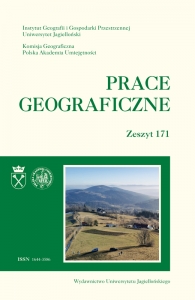STAN OBECNY I KIERUNKI ROZWOJU OŚRODKÓW NARCIARSKICH W POLSKICH KARPATACH
CURRENT STATE AND MAIN DIRECTIONS OF SKI RESORTS DEVELOPMENT IN THE POLISH CARPATHIANS
Author(s): Kinga KrzesiwoSubject(s): Rural and urban sociology, Sports Studies, Tourism
Published by: Wydawnictwo Uniwersytetu Jagiellońskiego
Keywords: ski tourism; ski resorts; development; the Polish Carpathians;
Summary/Abstract: Forecasts for the development of ski tourism in the world are not optimistic. They are related to the influence of climate change on the shortening of the ski season and the decrease in skier demand, as well as the progressive ageing process of the societies in eco- nomically developed countries. Therefore, ski resorts all over the world are faced with many challenges as a consequence of these phenomena. The purpose of this article is to present the current state of ski infrastructure in the Polish Carpathians and to define contemporary trends in the development of ski resorts in this area. The main methods used in the research process included inventory of ski infrastructure, field observation, analysis of the websites of ski resorts and their profiles posted on social media, and interviews with representatives of leading ski resort management companies. The state of infrastructure for downhill skiing in the Polish Carpathians in 2020 included 469 ski lifts, including 91 cableways, with a total length of 199.8 km and transport capacity of 400.8 thousand people per hour, as well as 528 ski runs with a total length of 304.7 km. The best developed tourist regions are the Tatras and Podhale region, as well as the Silesian Beskids. Among the 91 ski destinations in the Polish Carpathians, the best developed for skiing are: Białka Tatrzańska, Krynica-Zdrój, Wisła, Zakopane and Szczyrk. The most important development trends of ski resorts in the studied region are: modernization and construction of new, high-quality lifts (cableways, gondolas etc.); expanding the offer of ski resorts in terms of the summer season, especially for cyclists and families with children; combining the offers of many ski resorts in the region in the form of one joint ski pass; the use of special price promotions for the purchase of ski passes out of high season; using modern interactive tools for attracting customers; high concentration of tourist traffic in selected ski destinations; development of infrastructure for tourists travelling withmotorhomes. The actions mentioned above are the most commonly used adaptation tools toclimate and demographic changes that are aimed at increasing the profitability of ski resorts.
Journal: Prace Geograficzne
- Issue Year: 2023
- Issue No: 171
- Page Range: 101-124
- Page Count: 24
- Language: Polish

